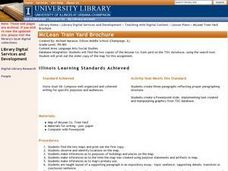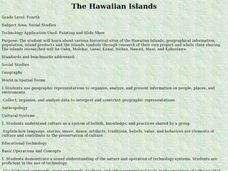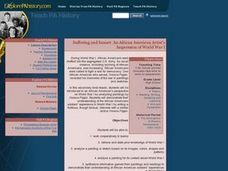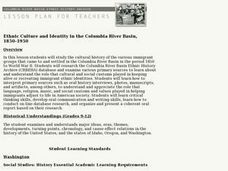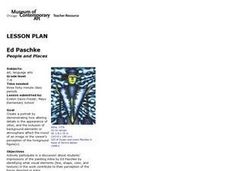Curated OER
Research North Carolina Symbols for a North Carolina Symbols Scrapbook
Fourth graders research North Carolina Symbols in a social studies textbook. They choose one to research in the computer lab for a scrapbook.
Curated OER
Multimedia Scavenger Hunt
Students design scavenger hunt questions to be answered using a multimedia encyclopedia after working on teacher made examples.
Curated OER
The Archaeology of Cactus Ruin
Young scholars simulate archaeologists by excavating a paper site. In groups, they use a sampling strategy to determine information about the people who lived at the site.
Curated OER
Desegregating the Kentucky Public School System
Students watch a video which chronicles the struggle to desegregate Kentucky's schools. They write a paper on a given aspect of what they saw in the video.
Curated OER
McLean Train Yard
Students conduct online research and incorporate graphics and maps into a Powerpoint presentation that details life at the McLean train yard in its heyday.
Curated OER
Whaling Slide Show
Tenth graders research a database on whaling. They search for photos that represent the whaling industry. In the classroom they use a projector and give a five-minute presentation.
Curated OER
Architecture the Wright Way
Eighth graders search a database for famous buildings in Illinois, and compare these structures to the designs of Frank Lloyd Wright.
Curated OER
The Hawaiian Islands
Fourth graders present information of people, places, and environments. They collect, organize, and analyze date to use with these representations.
Curated OER
Plants for Pleasure and Profit
Young scholars study about some of the specimens collected or diagrammed by Lewis and Clark, discuss their usefulness, and rank their importance. They write a persuasive essay detailing the plants they thought the most important.
Curated OER
Mapping the West
Students determine how Americans' perception of the geographical features of the West changed following the Lewis and Clark expedition. They analyze historical maps of the West.
Curated OER
Suffering and Sunset: An African American Artist's Impression of World War I
Students study paintings by a Pennsylvania artist, Horace Pippin, to explore African-American contributions in World War I. They create presentations based on their impressions of the artwork.
Curated OER
Writing Places American Communities
Students interview a member of the community and write a piece of poetry using the voice of the interviewee.
Curated OER
Who Are These Chinese People?
Students research the Han, a main Chinese ethnic group and the Hui, another numerous group. They write a paper about the Hui including geography, religion, eating habits, languages, politics and customs.
Curated OER
Active Citizenship
Pupils think critically and then present the information they have researched about the government.
Curated OER
Ethnic Culture and Identity in the Columbia River Basin, 1850-1950
Students explore cultural history of immigrant groups that settled in the Columbia River Basin from 1850 to World War II, and examine various primary sources to explore role cultural and social customs played in keeping alive immigrant...
Curated OER
"What Do You Mean?" How Language Changes Over Time
Learners examine words used at Jamestown in 1607. They predict what the words meant in 1607, write sentences using three of them, then analyze the sentences after they have read the actual definitions of the words.
Curated OER
What Lies Beneath
Students conduct Internet research on the history and archaeological excavations at historical Jamestown. They explore various websites, and develop a Powerpoint presentation to present to the class.
Curated OER
Networking at Early James Fort
Students examine the impact of global trade on regional civilizations of the world after 1500. They research and analyze images of pottery excavated at Jamestown, and create a poster that presents information about world trade networks...
Curated OER
Lesson 1: The Image of Maine in Sinclair Lewis' Babbitt
Students study excerpts from Sinclair Lewis, "Babbitt" for its accuracy and socio-economic point of view. They rewrite a portion of "Babbit" using the point of view of a Maine guide.
Curated OER
Row, Tow, Pull Your Boat
Third graders use previous knowledge and research to analyze and solve a scenario relating to the use of simple machines and the Lewis and Clark Expedition. They present their findings to the class in oral presentations.
Curated OER
Oh, Give Them a Home!
Fourth graders study the habitat of the American bison and its role in the life of the Native Americans. They investigate how the bison effect the Lewis and Clark expedition.
Curated OER
People and Places
Fifth graders investigate how the geography of the land effected the human experience of the Lewis and Clark Expedition. They research using primary and secondary sources, design a map.
Curated OER
Discovering the History of Our Community
Fourth graders explore the history of the Richfield Springs area through a guest speaker, historical pictures and postcards, and narratives from various histories of the area.
Curated OER
Chronology: They Time of My Life
Students demonstrate the importance of intact information to achieve accuracy. They compare and constrast their timelines with the chronological information contained in a stratified archaeological site.
Other popular searches
- Inca Artifacts
- Cultural Artifacts
- Archeology Artifacts
- Indian Artifacts
- Artifacts and Archeology
- Native American Artifacts
- Ancient Cultures Artifacts
- Historical Artifacts
- American Artifacts
- Ancient Chinese Artifacts
- Egyptian Artifacts
- Chicago Artifacts






